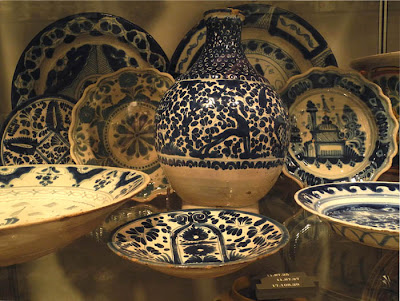I love things. I enjoy looking at all sorts of objects in antique shops; I even like spending time wandering the aisles of my local job lot store, admiring the shapes, colors, and textures of things on display, from housewares to rugs to clothing to foodstuffs. So it's a special treat for me to see a wide variety of decorative art objects and paintings collected in glass cases in the Luce Center Visible Storage, part of the American Wing at the Metropolitan Museum of Art. It is a place of delight and discovery, similar to another surprise find at the Met, the Greek and Roman study collection, which I wrote about a couple of years ago here; it inspired the first of my series of posts from the museum. The objects are arranged by material, and then by color, as in these blue and white ceramics....
or these brown earthenware pieces. At the rear is an amusing lineup of mugs, called Toby mugs or jugs, from the mid 19th century. There are few explanatory labels in this collection, but you can look them up by their number. For instance, that charming cow creamer was made in the mid 1800s by the American Pottery Company in Bennington, Vermont. I once had a contemporary white jug very similar to that.
Shimmering colors of blown glass bottles are arranged on shelves; they are similar in shape, yet each has a distinct personality.
I love the angular shape and honeycomb pattern of this tea set. It looks like it might have been made at the height of modernism, but it's from the Chelsea Keramic Art Works, ca. 1879-83. To see a high resolution photo of the set, go to the Met's website.
This is a marvelous pair of vases, so very different, each so expressive, one in color and one in shape. The brilliantly colored vase looks like a piece of glass, but is of earthenware, made in the early 20th century by Weller. Its green companion, with curving arms that seem to encircle a pair of wide eyes, is from the same period, the same material, and is by Gates Potteries.
This is a detail from a charming painting of a hunting scene (sorry, I didn't get label information). The horses' faces have more energy than the placid faces of the men. The legs of horses and dogs repeat as though in a low relief carving, and the scene is topped off by clouds billowing behind trees.
There was a great deal of furniture in the study collection: tables, and rows of chairs, desks and bureaus and chests. Many of them have decorative painting, as here with stylized flowers in a large simple container.
A similar floral motif is made into a elegant and sophisticated object, using inlaid woods instead of paint. This is a detail of a secretary that was made by Herter Brothers of New York in 1882; you can see the whole piece here. Although I'm sure that the Met has much of its collection hidden away, it's wonderful for us object lovers to be able to ramble through these study collections; they may be filled with things not quite good enough for the formal galleries, but they're a treasure nonetheless.








What a treasure trove. I bet they switch out the objects from time to time too so you don't see the same ole thing time and again. I too can roam the aisles of store goods. Always something to catch one's whimsy.
ReplyDeleteWhat a visual feast. I love having access to your eyes Altoon. Thank you for posting these, a celebration of thingness indeed.
ReplyDeletethanks for the comments, Lisa and Deborah; I'm pleased you enjoyed the tour. I feel I could write several blog posts on the stuff in that visible storage gallery.
ReplyDeleteOh, that green vase with the arms! It would look good filled with snowdrops. The new addition to the art museum at the UW has a study room like this filled with wonderful things of all sorts. For info, you look it up in a binder on the table based on id numbers. I love the ability to just roam in a room of lovely objects.
ReplyDeleteLinda, the Met has computer screens around the room where you can look up the info on the objects. Very user friendly.
Delete